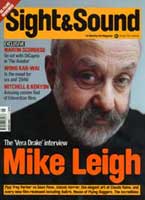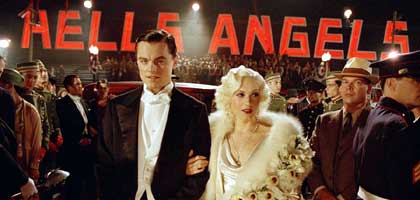
Fly Guy

Martin Scorsese hates to fly yet he has made The Aviator, a biopic about the billionaire Howard Hughes, played by Leonardo DiCaprio, for whom flying was more important even than womanising – the pursuit which lured him into the film business. On set, Ian Christie is stunned by the sheer scale of the enterprise
"Do you know who that is?" one of my companions whispered, clearly in awe. I didn't, but soon learned it was Gwen Stefani, platinum-haired lead singer of No Doubt, about to make her big-screen acting debut as the original blonde bombshell Jean Harlow. The occasion was a special screening in a Montreal preview theatre, arranged by Martin Scorsese, of his own print of Howard Hughes' 1930 Hell's Angels. Sitting behind Stefani as she watched the Hollywood legend she would soon play was just the beginning of an extraordinary visit to the looking-glass world of The Aviator.
Perhaps surprisingly for a film-maker so immersed in cinema history, this is Scorsese's first feature to deal directly with the movie business. Apart from his growing slate of documentaries about past cinema – after A Personal Journey with Martin Scorsese through American Cinema (1995) and My Voyage to Italy (2001), a piece about British film is in preparation – Scorsese has preferred to treat cinema itself obliquely. The Wizard of Oz and Gone with the Wind merge evocatively in the prelude to Alice Doesn't Live Here Any More (1974), while De Niro's Travis Bickle ineptly takes Cybill Shepherd on a date to a porn movie in Taxi Driver (1976), in true New Wave style. The heroes of GoodFellas (1990) and Casino (1995) may model themselves on movie gangsters, but their exploits and fates often undercut the glamour of other screen portrayals. On the voyeuristic fascination of cinema, Scorsese enjoys quoting ironically a line from Michael Powell's Peeping Tom: "All this filming isn't healthy." In fact, there has always been suspicion in Hollywood of films that risk puncturing the illusion or probing the motives of film-makers. Louis B. Mayer, who created and ruthlessly controlled Harlow, used to rail against "dirtying the nest", believing that audiences should remain innocent of what went on behind the scenes.
Mayer would certainly have hated a film about the mounting madness of Howard Hughes, which provides the narrative thread of The Aviator. Just as modern thinking about George III suggests he was far from simply mad, it may well be Scorsese's and his star and co-producer Leonardo DiCaprio's intention similarly to revise Hughes' reputation. Eccentric, driven, phobic – certainly Hughes was all of these; but was he not also touched by genius, or at least by an overweening ambition that produced some wondrous things? His greatest obsession was undoubtedly flying, and in Hell's Angels he combined an evocation of the already legendary Great War aviators with a new passion for cinema. Backed by funds from the engineering business Hughes had inherited from his father, the film was begun in 1927, clearly inspired by two recent Great War movies: King Vidor's The Big Parade (1925) and especially William Welman's flying drama Wings (1927). It was then overtaken during its long and lavish production by the runaway success of synchronised sound. Ever a perfectionist, Hughes decided to re-shoot dialogue scenes and adapt his spectacular flying footage to release the film as a talkie; for this he was able to borrow the English director James Whale, who had arrived in Hollywood to make the screen version of another Great War hit, the very different Journey's End (1930).
Both films, however, would be upstaged by yet another anthem to the doomed youth of 1914-18, Lewis Milestone's All Quiet on the Western Front (1930), which managed to premiere just a month before Hell's Angels. The Montreal studio shoot of The Aviator that I visited in summer 2003 had as its most spectacular sequence a recreation of the Los Angeles premiere of Hell's Angels at Grauman's Chinese Theatre. Towering above the studio buildings was Dante Ferretti's partial recreation of the famous cinema, which opened in 1927 with the premiere of Cecil B. DeMille's King of Kings and would later house the Academy Awards ceremonies. Although massive, the facade remained incomplete because the full range of spectacle required for The Aviator would emerge from a collaboration between Ferretti and Robert Legato, the special-effects virtuoso responsible for, among others, Apollo 13, Titanic and Armageddon. So this Grauman's still lacked its exotic topping and the hotel opposite had only its lower storeys, with the rest to be added digitally.
Talking to Legato gave an unexpected insight into his thoughtful approach to visual effects. Despite his background in advertising, his interest in effects owes much to the psychology of illusion, which links him to the magician-pioneers of early cinema. Having started his career near the beginning of CGI on Star Trek, he has seen digital enhancement grow from a sideshow to a major force. But he remains committed to serving dramatic purpose, combining built set with physical, optical and digital effects to produce a believable – if hitherto unfilmable – illusion. Interestingly, to know how some of the effects for Titanic and What Lies Beneath were produced detracts not at all from their impact.
Legato had already worked with Scorsese on the discreet effects required for Kundun (1997) and there had been talk of his joining Gangs of New York (2002) before Harry Potter and the Sorcerer's Stone claimed his attention. His presence and enthusiasm here have allowed The Aviator to become Scorsese's first major venture into digital enhancement. Much, however, had still to be built, and as the army of set-dressers and assistants swarmed over the forecourt of Grauman's, Scorsese's long-standing designer Dante Ferretti could be seen heading off to supervise the next major construction. Alongside his background improvising on location with Pasolini, Ferretti also worked with Fellini at Cinecittà and clearly relishes the architectural aspect of production design. Between building the massive exterior set for Gangs of New York at Cinecittà in Rome and arriving in Montreal he had spent many icy months in Romania overseeing the construction of an antebellum North Carolina town for Anthony Minghella's Cold Mountain.
Several nights after our introduction to the outdoor set we took an eerie drive through the old industrial area of Montreal for a sneak-preview of the art department's next project: a full-size recreation of part of the fuselage and wing of Hughes' greatest feat of aircraft construction, the 'Spruce Goose'. The H-4 or Hercules, as it was more formally known, remains the most famous monument to Hughes' ambition. Conceived during World War II for military logistics, it was and still is the largest plane ever built, constructed initially in wood because of wartime restrictions on materials. Hughes flew it only once, in 1947, to prove it was no turkey when he came under Senate investigation for wasting federal funds. Controversy still swirls around this monster, with some claiming it as visionary and others as symptomatic of Hughes' obsession overcoming his engineering know-how. But to stand beneath what will appear as an even more awesome structure in the finished film was to appreciate something of Hughes' vision, and what drew Scorsese and his collaborators to recreate it.
Back on the main set vast costume and make-up tents housed the horde of 'period fans' who would bring the Hell's Angels premiere to life. High above them another key member of the team was preparing for his part in the proceedings. Robert Richardson first worked with Scorsese as cinematographer on Casino, helping to create its garish yet elegiac splendour, and later shot the gritty, location-based Bringing Out the Dead (1999). He had come to The Aviator from Tarantino's Kill Bill and was unexpectedly operating the camera on a crane himself for the main premiere sequence. This was to involve DiCaprio arriving in front of the theatre with his entourage and walking on what becomes a carpet of broken glass as the massed photographers' flashbulbs fire. For one key shot, in true Scorsese style (recalling the great Copacabana sequence in GoodFellas), the camera would swoop down from a panoramic view of the scene to end on a tight shot of DiCaprio, showing Hughes' tension at this moment of public reckoning.
What sounds relatively straightforward is, of course, often far from simple to shoot – and re-shoot. As the vintage cars rolled to their marks at the end of the carpet and the fans and press surged forward, adjusting the Hughes party's progress to the camera's descent proved tricky. And for each new take the area had to be swept clear of glass while new bulbs were fitted in the period press cameras. The results, to judge from what could be seen on video-assist monitors, were excellent, showing how well DiCaprio could suggest his character's inner demons even in such a frenetic public setting. The crunch of the flashbulbs underfoot would eventually further underline the fragility of Hughes' psyche, torn between extremes of self-confidence and self-criticism. Meanwhile, both star and director showed remarkable patience over three long summer nights as the complicated chain of command running through a team of assistant directors under first assistant director Joseph Reidy kept the show at performance pitch.
That this is a film at least partly about film-making in Hollywood's golden age was brought home by the succession of actors arriving to tune into the atmosphere before appearing as stars of the past. After Stefani, Cate Blanchett, soon to become Katharine Hepburn, the great lost love of Hughes' life (at least in this version), arrived without noticeable ceremony; followed by Kate Beckinsale to play another Hughes inamorata of the 1940s, Ava Gardner. Perhaps the most intriguing film-history reference, however, was the idea of inviting the great editor Anne V. Coates of Lawrence of Arabia fame, already in town working on D.J. Caruso's Taking Lives, to play one of the team of editors working frantically to get Hell's Angels ready for its premiere. Thanks to The Aviator's editor Thelma Schoonmaker, we saw the extraordinary sequence in which Coates sits at a Moviola measuring shots by hand like lengths of cloth, while Richardson's camera corkscrews round the room to show 12 assistant editors – including Schoonmaker's own assistants – labouring to meet Hughes' demands. A private joke, certainly, but also a homage from the makers of The Aviator to one of the living legends of cinema history.
After Montreal the production went on to California to shoot other episodes from Hughes' life. As always with a historical film, it was instructive to realise how much collective and individual effort goes into so little screen time. Though The Aviator covers less than 20 years from the mid 1920s to the mid 1940s, stopping well short of Hughes' desert-recluse period dealt with in Jonathan Demme's Melvin and Howard (1980), it seems to have offered Scorsese a way to satisfy his own 'epic' impulses and his fascination with the US entertainment industry. During the 1980s and 1990s he worked on projects about Gershwin and Dean Martin which proved abortive. (When he described the latter as a potential "epic of American show business", Warners shuddered at the idea.) But Hughes offers a natural subject for an epic as well as an opportunity to delve into the hubris of extreme ambition "whom the gods would destroy they first make mad." So, against the odds, Scorsese has succeeded in pursuing his run of deeply divided personalities – aided by what looks like a committed performance from DiCaprio – as well as satisfying that desire of many film-makers to recreate the subjects of the cinema of their youth and delivering a movie acceptable to the bankers. Even at the price of making a film about his own least favourite experience – flying.
